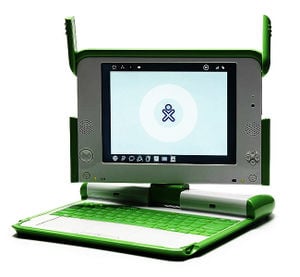ICT4D

Information and Communication Technologies for Development, or ICT4D, include:
- Telephone systems in developing countries (especially 2-way radios, and mobile phones)
- Internet access in developing countries
- Affordable computers and practical use thereof
Some examples of appropriate ICT4D are:
- The OLPC XO,W Simputer,W Eee PC,W Classmate PC, Studybook, PIC, Zonbu, Linutop, small form factor PC's[1] and other low cost computers are computers aimed for use in developing countries. Besides the low price, other characteristics include resistance to dust, reliability and use of the target language.
- Offline knowledge sharingW projects to give access to development information in areas without reliable and affordable internet access.
- The Wind-up radioW and the computer and communication system planned by the Jhai FoundationW are independent from power supply.
- GrameenPhone,W which fused mobile telephony with Grameen Bank's microfinance program to give Bangladeshi villagers access to communication.
- Mobile telephonyW is an appropriate technology for many developing countries, as it greatly reduces the infrastructureW required to achieve widespread coverage. However, mobile phone network may not always be available (it depends on the location) and may not always provide both voice and data services.
- Loband,W a website developed by Aptivate,W strips all the photographic and other bandwidth-intensive content from webpages and renders them as simple text, while otherwise allowing one to browseW them normally. The site greatly increasing the speed of browsing and is appropriate for use on low bandwidth connections as generally available in much of the developing world.
- An increasing number of activists provide free or very inexpensive webW and emailW services using cooperative computer networks that run wireless ad hoc networks.W Network service is provided by a cooperative of neighbors, each operating a router as a household appliance. These minimize wired infrastructure, and its costs and vulnerabilities. Private Internet protocolW networks set up in this way can operate without the use of a commercial provider.
- Rural electrical grids can be wired with "optical phase cable", in which one or more of the steelW armorW wires are replaced with steel tubes containing fiber optics.W
- Satellite Internet accessW can provide high-speed connectivity to remote locations, however these are significantly more expensive than wire-based or terrestrial wireless systems.[2]WimaxW and forms of packet radioW can also be used. Depending on the speed and latency of these networks they may be capable of relaying VoIPW traffic, negating the need for separate telephony services. Finally, the Internet Radio Linking ProjectW provides potential for blending older (cheap) local radio broadcasting with the increased range of the internet.
- SatelliteW-based telephone systems can also be used, as either fixed installations or portable handsets and can be integrated into a PABXW or local IP-based network.
Key principles of ICT4D equipment[edit | edit source]
ICT4D equipment needs to comply to the principles of appropriate technology so as to make the benefits of these technologies as widely available as possible. Following are general principles and will vary according to the specific application and context:
- Minimize power usage, because:
- Less power means less infrastructure, and infrastructure can be expensive
- Power means heat, means fan, which means sucking in dust, which means breakage and need for repairs; it also means all parts of the system heat up, which can lead to malfunctions. So the less power, the less breakage.
- Locally maintainable, through a combination of:
- Ease of use and repair
- Interchangeable, standard parts as far as possible. This is not strictly possible in a village context, but don't be more exotic in hardware choice than necessary.
- Upgrades and reinstalls freely available without need for payment. The use of open source software has the advantage on this point.
- Training
- Support materials in the local language, or (next best option) in a language that local people can understand.
Affordability of ICT4D equipment[edit | edit source]
The cost of ICT4D equipment such as computers drops every every 2 years, by about 50%. This is an observation called Moore's law.W A practical consequence of Moore's law is that software and content developers rarely need to think about the affordability of hardware. Developers can simply build their applications, knowing that sooner or later their target audience will be able to afford the computers to run their applications. Eventually the cost of computing could be lower than the cost of a subsistence diet, putting computers within the budget of anyone who has managed to stay alive.
See also[edit | edit source]
- DecTop, LinuTop, and other nettops or small form factor PC's,[3] combined with Lumenlab Evo 1.2 or diy-projector
- Raspberry Pi
- Green IT, which shares a focus on minimal resource use.
- Autonomous houses and neighbourhoods#Communication
External resources[edit | edit source]
- The Inveneo ICT Sustainability Primer
- http://en.wikipedia.org/wiki/Digital_divide#See_also
- Appropriate ICT as a Tool to Increase Effectiveness in ICT4D: Theoretical considerations and illustrating cases - Victor van Reijswoud
References[edit | edit source]
- ↑ These can still be taken along in a backpack and ie foreseen with a projector/stationary screen and laser keyboard]
- ↑ Preposition for a satellite internet access system
- ↑ These can still be taken along in a backpack and ie foreseen with a projector/stationary screen and laser keyboard]